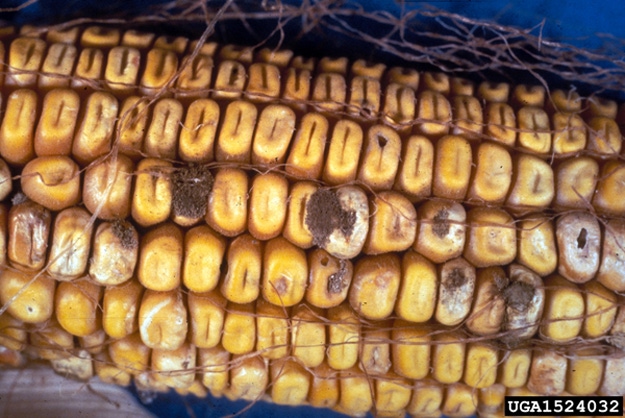October 1, 2012

Once grain is dry and cold, or even just cold, the Aspergillus flavus fungus is rarely able to grow and produce more toxin. However, at least two problematic situations are arising: bin dryers operated at medium temperatures (below 120° F) and high variability of moisture within fields.
The optimum temperature for aflatoxin production is 75-95° F with moistures greater than 18%. A bin dryer operating with input air below 120° F will “store” the grain during drying at these temperatures. If the bin is full, drying times of four to six days are not uncommon. In this case, grain already containing the Aspergillus fungus can experience increased aflatoxin levels.
The correction is to increase drying air temperatures beyond 120° F. Some bin drying systems with rapid stirring systems can go as high as 160° F; others with less grain circulation may be limited to around 140° F. Half batches will also help; shallower grain depth will increase airflow and cause less grain be held at higher moistures. It would be better in this case to dry two half batches instead of one full batch. The outside air temperatures have fallen enough that the corn in the field is now less likely to increase in toxin. Holding it in the field may be preferable to having it warm in a dryer.
High-temperature batch and continuous-flow dryers are not susceptible to this problem, but wet corn should be held in high airflow wet holding (to maintain cold temperatures) or in the field. As an example, conditions of about 80° F and 30% relative humidity will hold aerated wet grain at about 45-50° F because of evaporative cooling of dry air. This is below the growth conditions for Aspergillus flavus mold, although in time other more temperature-resistant fungi will grow at those temperatures. Low-temperature, natural air drying will also work under these conditions because the wet grain will not be warm enough to sustain the fungus.
In some cases, very high ranges of moisture are being experienced within the same field, for example, 15-30%. Dryers will not equalize this moisture in one pass; there will be some wet corn remaining even after the average reaches 15%. Low temperature is the only control method for this situation; extra cooling cycles to bring the grain temperature immediately below 50 °F.
Corn will segregate somewhat by moisture if it is drop filled in a bin; this means that both the high moisture and the fines will collect in the center. It will be very important to remove the center core right away; in large bins (over 50 ft. diameter), two removals would be advisable.
Pay attention to the yield monitor moisture output to estimate which fields are likely to be a storage problem from moisture variations. Crop insurance will not cover quality issues after harvest.
Charles Hurburgh is a professor in the Department of Ag and Biosystems Engineering. He can be reached at 515-294-8629 or e-mail [email protected].
You May Also Like




